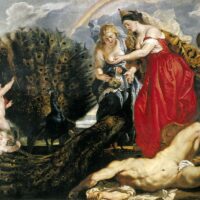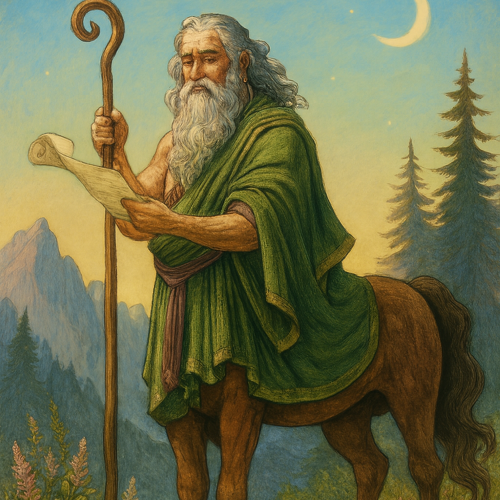Argus Panoptes : The All Seeing Guardian
Listen
At a glance
| Description | |
|---|---|
| Origin | Greek Mythology |
| Classification | Hybrids |
| Family Members | N/A |
| Region | Greece |
| Associated With | Protection, Watchfulness |
Argus Panoptes
Introduction
Argus Panoptes, whose name translates to “All-Seeing Argus,” is one of the most remarkable figures in Greek mythology. He is remembered for his hundred eyes and his role as Hera’s most loyal sentinel. With eyes scattered across his body, Argus was able to maintain unbroken vigilance, embodying the concept of watchfulness and divine order. His most famous myth revolves around guarding Io, a mortal woman whom Zeus transformed into a cow to conceal his infidelity from Hera. The tale of Argus Panoptes captures themes of jealousy, loyalty, and deception, while his ultimate fate—slain by Hermes—ensures his place in the mythological tradition as both a powerful guardian and a tragic figure.
Physical Traits
Argus Panoptes is consistently described as a giant covered in eyes, though ancient writers disagreed on the exact number. Hesiod, in his lost work Aigimios, gave him four eyes, while Ovid in Metamorphoses declared he had one hundred. These eyes were not only symbolic but also practical: some could rest while others stayed open, granting him unending vigilance. In visual depictions, his eyes are shown on his head, chest, arms, and legs, emphasizing his omnidirectional sight. Argus was also renowned for his immense physical strength. He is said to have slain a destructive bull in Arcadia and wore its hide, a detail that marks him as both warrior and watchman. This combination of physical might and supernatural vision made Argus one of the most formidable guardians in Greek mythology.
Family
The origins of Argus Panoptes vary widely across different sources, a common feature of Greek mythological genealogies. In one version, he is the son of Arestor and Mycene, making him a mortal-born hero elevated to near-divine status. Another tradition identifies him as the child of Gaia, born directly from the Earth, which ties him to the primeval order of nature. Some accounts list Inachus, the river god of Argos, as his father, while others cite Argus and Ismene, daughter of the river god Asopus. These conflicting genealogies show how Argus was not only a character within myth but also a symbolic figure rooted in the land of Argos itself, a protector tied to its divine and earthly heritage.
Other names
The title “Panoptes” (πανόπτης), meaning “all-seeing,” is the epithet that defines Argus. It highlights his unmatched vigilance and serves to distinguish him from other figures also named Argus in Greek mythology. The name “Argus” itself comes from the Greek word argós, meaning “bright” or “shining,” a fitting description for one whose watchfulness never dimmed. After his death, Hermes acquired the epithet “Argeiphontes,” which means “slayer of Argus,” forever binding the two figures in mythological memory. Argus’s eyes, according to one tradition, were transferred by Hera into the tail of the peacock, her sacred bird, ensuring that his legacy lived on in divine symbolism.
Powers and Abilities
Argus Panoptes’s greatest ability was his tireless vigilance. With countless eyes scattered across his body, he could never be taken by surprise, making him the ideal guardian. Even when asleep, part of him remained awake, ensuring continuous watch over whatever or whomever he was tasked to guard. His most famous duty was to keep Io, transformed into a heifer, under constant surveillance for Hera. Beyond his watchfulness, Argus demonstrated great strength and courage. He is credited with killing the monstrous Echidna, the half-serpent, half-woman creature known as the “Mother of Monsters.” He also subdued troublesome beasts and bandits that threatened order in Arcadia. These exploits portray Argus not just as a passive watcher but as an active enforcer of divine will, embodying both perception and protection.
Modern Day Influence
The story of Argus Panoptes continues to resonate in the modern world, where his hundred eyes have become a metaphor for surveillance, knowledge, and omnipresence. After his death, Hera immortalized him by placing his eyes on the peacock’s tail, a motif that endures in art and symbolism. The peacock itself later came to represent immortality and divine vision, extending Argus’s influence beyond Greek religion into Christian iconography.
In literature and philosophy, Argus Panoptes has inspired discussions of power and control. The term “panoptic” derives from his name and is widely used in the context of Michel Foucault’s interpretation of Jeremy Bentham’s Panopticon—a prison design where inmates could be observed at all times. Scholars also use “Panoptes” in discussions about modern surveillance states, artificial intelligence, and technologies of observation, drawing parallels between his unblinking eyes and the watchful systems of the digital age.
In art, Argus appears in works by painters such as Peter Paul Rubens, who captured the dramatic moment of Hermes lulling Argus to sleep. Salvador Dalí’s surrealist imagery also drew on the symbolism of Argus, linking him to perception and vigilance. Contemporary installations like Laurent Grasso’s “The Panoptes Project” reimagine Argus as a metaphor for technological surveillance in public spaces.
Popular culture has also embraced Argus Panoptes. In Neil Gaiman’s American Gods, he is reimagined as the “God of Surveillance,” embodying modern systems of cameras, drones, and data monitoring. In technology, his name has been adopted by security systems, satellite projects, and data analysis frameworks, emphasizing his association with constant watchfulness. Even in educational settings, Argus Panoptes is used as a teaching tool to explore themes of digital safety and social control, showing how an ancient myth can illuminate modern concerns.
Related Images
Source
Kapach, A. (2023). Argus Panoptes. Mythopedia. Retrieved from https://mythopedia.com/topics/argus-panoptes
Wikipedia contributors. (2023). Argus Panoptes. Wikipedia. Retrieved from https://en.wikipedia.org/wiki/Argus_Panoptes
History Cooperative. (2023). Argus in Greek Mythology: The Many-Eyed Guardian. Retrieved from https://historycooperative.org/argus-greek-mythology/
Ovid. (8 CE). Metamorphoses (Book I). Translated by A.D. Melville. Oxford University Press.
Frequently Asked Questions
What is lorem Ipsum?
I am text block. Click edit button to change this text. Lorem ipsum dolor sit amet, consectetur adipiscing elit. Ut elit tellus, luctus nec ullamcorper mattis, pulvinar dapibus leo.
What is lorem Ipsum?
I am text block. Click edit button to change this text. Lorem ipsum dolor sit amet, consectetur adipiscing elit. Ut elit tellus, luctus nec ullamcorper mattis, pulvinar dapibus leo.
What is lorem Ipsum?
I am text block. Click edit button to change this text. Lorem ipsum dolor sit amet, consectetur adipiscing elit. Ut elit tellus, luctus nec ullamcorper mattis, pulvinar dapibus leo.
What is lorem Ipsum?
I am text block. Click edit button to change this text. Lorem ipsum dolor sit amet, consectetur adipiscing elit. Ut elit tellus, luctus nec ullamcorper mattis, pulvinar dapibus leo.
What is lorem Ipsum?
I am text block. Click edit button to change this text. Lorem ipsum dolor sit amet, consectetur adipiscing elit. Ut elit tellus, luctus nec ullamcorper mattis, pulvinar dapibus leo.












